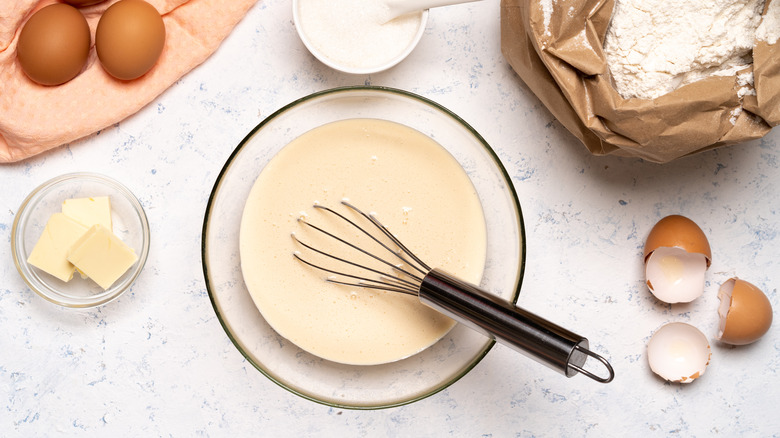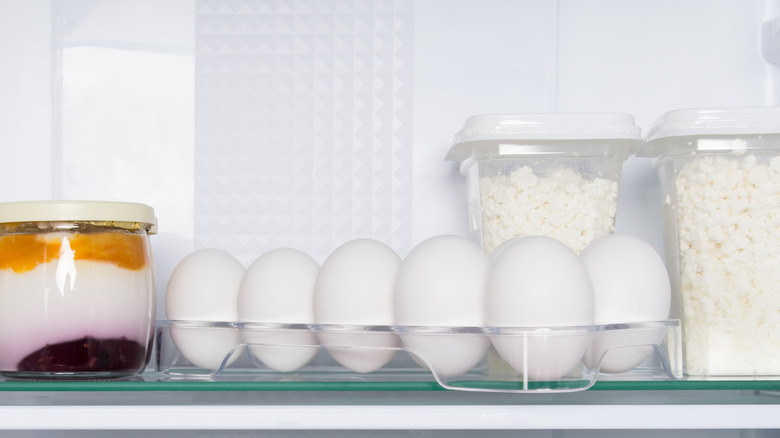The Quickest Method For Getting Eggs To Room Temperature
We've all been there. It's the end of a long week, and you are jonesing for something sweet to celebrate. So, you excitedly pull out your favorite chocolate chip cookie recipe and scan the list of ingredients. Flour – got it! Brown sugar -- right here! Then you see it: room-temperature eggs.
You know bringing eggs to room temperature requires time, and you wish you had thought to take the ingredients out an hour ago. But that time is lost, and you don't want to wait. You want those delicious, gooey, brown butter chocolate chip cookies now.
You consider that it will probably be fine if you use cold eggs, right? According to King Arthur Baking, it depends on the recipe's method and the type of food you're baking. Chances are it won't ruin the recipe entirely, it'll just change the texture.
Still, don't be too quick to go off-script. Bakers call for room-temperature eggs when they specifically make a recipe better. Although using room-temperature eggs can seem like a minor detail, skipping important ingredient cues can make the result less desirable. The last thing you'd want to do is put in all your effort to make something tasty only to be disappointed with how it came out.
Why use room temperature eggs when baking?
When a recipe calls for room-temperature eggs, it's for a good reason. Using cold eggs in place of room-temperature eggs can affect the outcome by causing problems with texture, increased cooking times, and lumpy batter (via The Incredible Egg).
A smooth batter is particularly important in delicate recipes and recipes that have a silky texture. In a cheesecake, for example, if there are lumps in the uncooked mixture, the cheesecake will have lumps when it's cooked. Cake and flour-based goods are more flexible, but you'll still find some value in using room-temperature eggs.
According to America's Test Kitchen, room-temperature eggs whip better. The test kitchen experimented with using the same cake recipe baked twice. One version used room-temperature eggs, and the second recipe used cold eggs. The room-temperature eggs resulted in a light cake with a fine crumb, whereas the cake with cold eggs was denser and took longer to bake. They concluded there was no actual harm in using cold eggs for the cake recipe, but it can be harder to achieve the goal texture of the dessert. Generally, it's always ideal to plan ahead so you can use room-temperature eggs to achieve the best results.
Are room temperature eggs safe?
If you've forgotten to take the eggs out of the refrigerator, keep in mind it will take a while for them to warm up. The America's Test Kitchen trial concluded that on average, eggs needed 65 minutes to reach room temperature. The United States Department of Agriculture's Leftover and Food Safety Guidelines, state that leaving refrigerated food in a warm environment above 40 degrees Fahrenheit supports bacterial growth and increases the possibility of a foodborne illness.
So wouldn't room-temperature eggs be a recipe for disaster?
Not necessarily. The answer comes down to the duration that the egg remains at room temperature. If you plan on leaving eggs on the counter all day while you're at work so you can come home and start baking right away, you'll want to reconsider.
In the U.S., eggs are typically refrigerated. Refrigerating eggs is not required in other parts of the world, as the processing of fresh eggs may vary. However, according to NPR, the U.S. requires that eggs are to be washed before selling. Washing the egg removes the protective layer of the shell that resists water and bacteria from entering. With the protective coating removed, bacteria can more easily penetrate the surface.
Food safety guidelines state that room-temperature eggs should be left out of the refrigerator for no longer than two hours (via USDA). Eggs are often safe when initially warming to room temperature. Still, you'll want to use them quickly once they reach about 70 degrees Fahrenheit.
The quickest method to bring eggs to room temperature
Luckily for those who bake on impulse, there's a quick method to bring eggs to room temperature. This trick lets you bring eggs to a warm temperature in just minutes versus waiting over an hour. No longer will you have to scrap those dessert plans because you don't have any room-temperature eggs ready to go.
You only need a bowl of warm water to quickly bring your eggs to room temperature. The process takes 5 to 10 minutes, depending on the egg size, water temperature, and temperature at which you keep your fridge. First, you'll need to choose an appropriately sized bowl, depending on the number of eggs you need for the recipe. Next, place the eggs that are whole and still in the shell into a bowl, and cover them with lukewarm, not hot, water. Allow the eggs to sit in the bowl and warm up (via Cook's Illustrated). Once the eggs feel about the same temperature as the water, they are ready to use. It's that easy!
Don't settle for cold eggs the next time you get the urge to whip up a red velvet cake at the last minute. Instead, use this quick method for getting eggs to room temperature. Place the eggs into the warm while you collect the other ingredients and you'll be ready to bake in no time!



